
Nintendo is a name that is well-known all over the world. They have made a name for themselves as one of the largest and most popular video game companies ever. From series such as Super Mario, The Legend of Zelda, and Kirby, Nintendo is a company that seems like it will never slow down on making video games any time soon. Nintendo was not always a video game company, however. They have gone through many different types of products throughout the 135 years they have existed. They have done everything from Japanese playing cards to toys to food to the eventual creation of video games. With almost every product they have focused on, however, Nintendo has been able to innovate in unique and exciting ways that could apply to anyone of any age, be they children or adults, while at the same time making products that can be simple yet effective in the long run.
When Nintendo was created in Kyoto, Japan in 1889, they were not even called Nintendo. That name would not appear until many years later down the line. The company was named Nintendo Koppai and was created and run by a Japanese businessman named Fusajiro Yamauchi. 1 At this time, Nintendo did not make video games, as they would not exist until over half a century later. At the time, their product of focus was a Japanese game known as Hanafuda, which roughly translates to ‘flower cards’ in Japan. Hanafuda cards are a unique form that differs from American playing cards and may be more familiar to American audiences. Instead of numbers and symbols standard on American playing cards, the cards used for Hanafuda would feature Japanese-style drawings of objects that fall into a natural variety, such as flowers and animals, specifically different types of birds.2
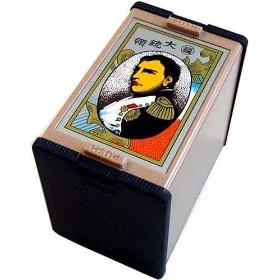
The different designs of the cards were intended to avoid being associated with gambling, which was illegal in Japan at the time. Despite this, distinct images could be represented by various numbers to make the game a little easier. People who were fond of gambling liked this as they felt it strayed away enough from the authorities, who said gambling was not allowed and allowed them to gamble in secret. 3Nintendo made a select few variants of these card decks. The most famous deck, however, was the Daitouryou deck, which roughly translates to ‘President’ in Japanese. These cards featured a painting of Portrait of Napoleon Bonaparte on the front, an image that is still used by Nintendo in some instances today. Even though Nintendo is mainly a video game company now, they will still produce Hanafuda cards for Japanese audiences that replace natural images with pictures of their modern characters, such as Mario. This shows that these cards became popular enough to sell to a contemporary audience, with updates that fit more with the times.
The company of Nintendo Koppai would continue to make and distribute Hanafuda cards through the year 1933. At this point, Fusajiro stepped down from the company. In his place came his son-in-law, Sekiryo Yamiuchi. He renamed the company Yamauchi Nintendo and Co. for the first time. Due to unfortunate circumstances in the year 1950, Sekiryo suffered a stroke, and once again, the company had a new president, Shikanajo Yamauchi. However, after Shikanajo abandoned his family soon after coming in as president, his son Hiroshi took over the company. Hiroshi is famous for being the longest-standing president of Nintendo, as he held office from 1949, when Nintendo was still making cards, until 2002, when Nintendo was already known as a video game company. 1 Once again, the company was renamed into the Nintendo Playing Card Company. However, at this time, Hiroshi realized that regular Hanafuda cards, while popular, were probably not the best way to keep the company afloat. They only applied to adults for the most part, which was unfortunate because they could have made products that pertained to a much larger audience, such as families and children. However, in 1959, Hiroshi did something exciting and something that could be considered Nintendo’s first significant innovation. He partnered with the famous American animation company Walt Disney Co. to produce Hanafuda cards featuring Disney characters such as Mickey Mouse, Minnie Mouse, Donald Duck, and even non-Mickey Mouse Characters such as Bambi. 5
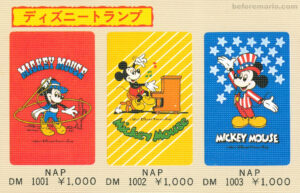
This was interesting as this was the first time that Nintendo strayed away from strictly adult-oriented products and focused on products that could pertain to families and children alike, an ideology that Nintendo continues with to this very day. Soon after, Hiroshi changed the company’s name one final time, bringing in the name Nintendo, which is still well-known today. 6
The Hanafuda card business was starting to dip, so Hiroshi wanted to venture into other products and grow their market. He experimented with Nintendo selling taxi services, various foods, a Roomba-esque vacuum cleaner, and many other products. While many of these products could be considered exciting and high-end, the unfortunate thing is that almost all failed miserably and brought Nintendo to bankruptcy. 7
In the 60s, when Nintendo was down on their luck, they realized that their card-making experience and contribution to Walt Disney could work in their favor. They began to make licensed board games, some of which had collaborations with Disney once again and other companies that were more popular in Japan, such as Ultra-Man. Once again, like the Disney Hanafuda cards, these games were successful as they focused on fun for families and children. However, not soon after that, one of the most influential Nintendo employees came into the limelight and started the path to changing Nintendo into the company that is so known and well-loved today, Gunpei Yokoi. 8 Gunpei Yokoi started as a low-level Nintendo employee whose job was to make cards for the company that made them famous in the first place. However, that does not mean that Yokoi would not branch out into his areas of innovation. Yokoi invented a simple grabber toy that most people would not bat an eye at nowadays. However, when Hiroshi saw Yokoi playing with it, he realized that he may have a prodigy on his hands. Nintendo and Yokoi decided to mass-produce the toy in the Christmas season of 1966, giving it the title of Ultra Hand. 9
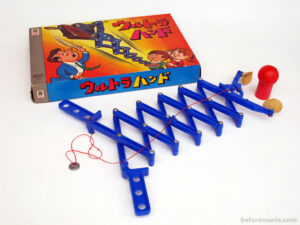
The toy became a massive success, moving Nintendo from being a card company to focusing specifically on toys and entertainment. Many of the toys that Nintendo would make throughout the ’60s and ’70s would also be huge successions. At the same time, however, Nintendo’s modern innovation started to shine. Many of these toys, such as a baseball launcher and an electronic car launcher, take simple concepts and make toys that could even be considered impressive today. On top of this, Nintendo would make toys that, at least in name, would eventually become early Nintendo games, such as an early version of Duck Hunt and the previously mentioned car launcher, which would become Mach Rider. The exciting thing about these toys is that, once again, they were simple. However, the genius mind of Yokoi was able to take these simple concepts, such as a car launcher, and make them fun so that even kids and adults could enjoy them even today. This is, once again, an idea that Nintendo would continue to use in their products. 10
Nintendo made toys for the rest of the 1970s and gained a significant profit. However, soon after, Gunpei Yokoi would have an experience that would change Nintendo forever. He was sitting on a train on the way to work, minding his business, when he noticed another businessman sitting on the train. The man was fiddling around with a calculator, seemingly just to be able to give his fingers something to do while at the same time entertaining himself. With this experience, he decided to use this technology and create a new product. One that could be considered the first proper video game system that Nintendo ever made is the Nintendo Game & Watch. Yokoi released the first Nintendo Game & Watch in 1980, Ball. The game’s goal was to juggle balls until one of them dropped, at which point you would lose. The game was simple and used the same technology that one would find in a calculator, but that did not make the game fun. It was a high-score game, where you would try to get the highest score before losing. At the time, this was different, and Nintendo would continue to innovate with the Game & Watch system line as new versions were released. Many video game players think the famous pad, a four-direction button used to move a character with many earlier and even modern video game controllers, was introduced into gaming with the Nintendo Entertainment System in 1985. This innovation changed the world of gaming. It showed that games could be made in a portable sense, thus meaning they would not be as advanced but still make fun and exciting games in their own right.
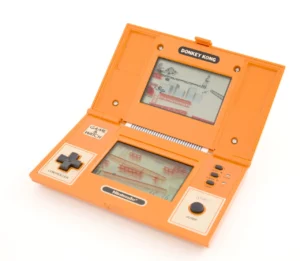
Fans of Nintendo may think that the clam-shelled design of video game systems was made famous by the Game Boy Advance. However, that is not the case. These ideas were put into the Game and Watch in the early 1980s. Many more of these systems would continue to be released in the 80s and 90s and innovate in unique ways, such as double-screen games and separate controllers. and even color gaming on handheld systems. 11 As the Game & Watch continued, Nintendo continued with arcade machines in the video game market. Unfortunately, most of the ones released in the late 1970s and early 1980s were not the biggest hits. However, one man would change everything, and that was Shigiru Miyamoto.
Shigeru Miyamoto was not a leader at Nintendo at first. In his early days working for the company, he worked in the art and design aspect, helping to design how the games that Nintendo wanted to make. 12 In the early 1980s, however, Miyamoto wanted to make a game based on the early 1900s American cartoon Popeye the Sailor Man. Unfortunately, however, Miyamoto could not acquire a license to make the game, so the original idea was scrapped. However, Miyamoto decided to create his characters in his own game. That game would become Donkey Kong in 1981. The characters in 1981 were based on the characters from Popeye. Mario was replaced with a character called Jumpman, later renamed Mario. Olive Oil was replaced with a damsel in distress named Pauline. Finally, a giant menacing ape named Donkey Kong replaced the big and wrong Brutus. While these characters were just replacements at first, one would become one of the most significant video game characters ever. 13
The game became an absolute smash hit when Donkey Kong was released in 1981. The game was an innovation because it was widely considered first example of the Platformer genre of video games that Nintendo would popularize later on. The game aimed for players to move Jumpman through construction sites, avoiding barrels thrown by Donkey Kong and other hazards. Games like this had never been seen before, showing how different and unique video games can be. The game would continue to go on and earn a large amount of money for Nintendo while at the same time giving them the framework to make their next arcade hit: Mario Bros.
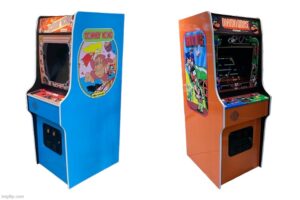
In 1983, Miyamoto wanted to expand on the idea of Donkey Kong in a new but similar game. In this game, however, Donkey Kong and Pauline were no longer there. Jumpman remained, however, but was given a new name with Mario. The goal of this game was also simple. the goal was to control Mario through a sewer and destroy enemies by jumping at them from below. In Nintendo and Japan alike, this game was also a hit. It was able to innovate in the sense that it started what could be considered a bit of a revolution with the character of Mario, as it introduced the character to the mainstream and was successful not just in Japan but worldwide. This game helped fully introduce the world to a character that would end, leaving a much more significant impact not even two years later when the Nintendo Entertainment System was released.
After the success of Donkey Kong and Mario Bros, Nintendo had the idea of making a console to play in your home. This was a big move as many popular home game consoles, such as the Atari 2600, were brought out of the limelight due to the gaming crash in the early 80s. This was a time when games were being pumped out left and right without any quality control showing whether the games were good. As such, the popularity of video games dwindled in the early 80s to a point where it seemed that video games in the home would go extinct. However, Nintendo felt that they could help with that. They wanted to create a system that was simple yet fun, much like their old toys and video game handhelds such as the Game & Watch, while at the same time giving a seal of quality on all of their games. With these ideas in mind, the Nintendo Entertainment System was released in 1985. This system was nothing new in the forefront. The game used carts, just like other early home video game consoles, and while the graphics were more advanced than before, they were still relatively simple. However, Super Mario Bros. was a game that would make the NES the success that it was.
When Nintendo released the NES in 1985, they bundled the game Super Mario Bros. with it. This game was a sequel to Mario Bros. if you will, and a significant improvement. Instead of focusing on one screen, the game allowed the player to traverse through significant horizontal levels, 32 of which were exact.
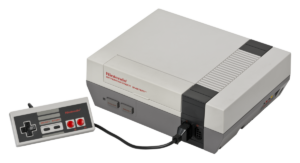
The game also introduced the idea of power-ups in Mario’s world. These included a mushroom that made Mario grow and size and let him take damage without dying, a flower that let him throw balls of fire and a star that gave Mario invincibility. These ideas had also not been seen in video games either, be they ones in arcades or ones that would be played at home. On top of this, Nintendo made it so you could control the game with the D-pad introduced in the Game & Watch and only two other buttons. The game became a massive success, giving Mario a name, spawning many sequels and spin-offs, and making Nintendo the king of the video game industry for a long while. Without their power to innovate, however, there is a good chance that video games could have failed forever. 14
So Nintendo seems to have quite the history before they started the creation of video games. But what does it all mean? From what I have found, I can see that even in the company’s worst and most unique times, Nintendo can innovate and adjust to the times and the consumer. Almost all of the products that Nintendo has made it to other video game systems. On top of this, Nintendo stopped video games from becoming a fad and put them into the mainstream. Without Nintendo, video games and many other products they tampered with would not be the way they are today. Even if a person may not be a gamer, Nintendo has been able to innovate by creating IPs and characters that can be represented in not just video games but also movies, television shows, and other forms of media, on top of the various products and creations they made that innovated as well. If you ask a person to name a Nintendo game or character, they will likely be able to.
- “Nintendo History.” Nintendo of Europe AG, www.nintendo.co.uk/Hardware/Nintendo-History/Nintendo-History-625945.html#1980. Accessed 26 Mar. 2024. ↵
- “Revisit Nintendo’s Roots with Hanafuda.” Nintendo of Europe AG, www.nintendo.co.uk/News/2021/August/Revisit-Nintendo-s-roots-with-Hanafuda-2019412.html. Accessed 28 Mar. 2024. ↵
- Sheff, David. Game over: How Nintendo Conquered the World. GamePress, 1999. ↵
- “Nintendo History.” Nintendo of Europe AG, www.nintendo.co.uk/Hardware/Nintendo-History/Nintendo-History-625945.html#1980. Accessed 26 Mar. 2024. ↵
- .“Nintendo History.” Nintendo of Europe AG, www.nintendo.co.uk/Hardware/Nintendo-History/Nintendo-History-625945.html#1980. Accessed 26 Mar. 2024. ↵
- “Nintendo History.” Nintendo of Europe AG, www.nintendo.co.uk/Hardware/Nintendo-History/Nintendo-History-625945.html#1980. Accessed 26 Mar. 2024. ↵
- “Nintendo Before Video Games.” Youtube, uploaded by ScottTheWoz, 15 Apr. 2018, www.youtube.com/watch?v=yx1hNOKMvyM. ↵
- “Nintendo History.” Nintendo of Europe AG, www.nintendo.co.uk/Hardware/Nintendo-History/Nintendo-History-625945.html#1980. Accessed 26 Mar. 2024. ↵
- Various. Gunpei Yokoi the Life & Philosophy of Nintendo’s God of Toys. Les Editions Pix’N Love, 2013. ↵
- “Nintendo History.” Nintendo of Europe AG, www.nintendo.co.uk/Hardware/Nintendo-History/Nintendo-History-625945.html#1980. Accessed 26 Mar. 2024. ↵
- Hayward, David. “REMEMBERING…Nintendo Game & Watch.” Micro Mart. ↵
- Chatfield, T. (2010). “From Donkey Kong to Wii Sports: How One Man Taught the World to Play,” Tom Chatfield salutes Nintendo’s Shigeru Miyamoto – still a visionary after 30 years in the games industry. Sunday Times. ↵
- Latson, Jennifer. “How Donkey Kong and Mario Changed the World.” Time.Com, June 2015, p. N.PAG. EBSCOhost, research.ebsco.com/linkprocessor/plink?id=9de3a94a-e5d4-3d40-9e99-912d1ab94de5. ↵
- Chatfield, T. (2010). “From Donkey Kong to Wii Sports: How One Man Taught the World to Play, Tom Chatfield salutes Nintendo’s Shigeru Miyamoto – still a visionary after 30 years in the games industry.” Sunday Times. ↵


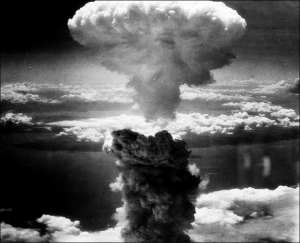
9 comments
Jordan Robbins
Hi! Thanks for explaining the significance of Nintendo. I learned a lot about their history and how they changed history through the various video games. I didn’t know that their president had been Hiroshi for that long! I also really enjoyed the presentation and how it was explained! Everything looks great and thorough! What influenced or encouraged you to create this infographic?
Carlos Anthony Alonzo
Your article of Nintendo’s evolution leading up to the release of Super Smash Bros was like a breath of fresh air. Well done! Your article highlights the company’s remarkable journey in the gaming industry. From the humble beginnings to the now cultural icons we all know and love to this day. Nintendo’s contribution to gaming shows a rich history that provides interesting insight into the impact of gaming on culture. Again, nice job!
Sebastian Hernandez-Soihit
Interesting! I did not know the story behind game & watch or the initial roless that characters like Shigeru Miyamoto had on the growth of the company, less so how different a trajectory they had before they jumped into the video game industry. Very informative and full of great sources.
Nicholas Pigott
Hi Aidan! What a fascinating article! I grew up with Nintendo as a kid, starting with the original Wii, so it holds a special place in my heart. It’s so interesting to learn about the history of such a great company, and it’s mind-blowing how old Nintendo actually is, starting from toys and playing cards all the way to now. Congratulations on your nomination!
Ana Barrientos
Hi Aidan, this article was super interesting! Growing up some Nintendo was popular and still is, especially playing the Wii and playing Wii sports. It was a part of almost everyones childhood, and so nostalgic. It was great learning about how Nintendo came to be, and you can still see impact of Nintendo now especially with the switch. Overall, great job!
Leaya Valdez
Hi Aidan, I found this article very interesting to read not only because it was very informative on the history of Nintendo but also because growing up Nintendo was a big household name in my family so being able to know the history of how it became such a big company and what impact it made to the world was very interesting to read about.
Jonathan Flores
I think this article is very interesting and well done. First, I would like to say how we often think of Nintendo as the pop culture giant it is without realizing that it was once a tiny brand as all others. In this way, the article perfectly conveys the development and informative nature of Nintendo’s history. The same way Amazon started as a book company; I was not aware that Nintendo started as a card company and is one of those facts that will surely stick with me. Overall, great article.
Paola Then Ortiz
Hey Aidan! I enjoyed reading this article, I grew up playing Nintendo DS, and reading this article helped me know the origin of Nintendo and how it became a big company. I did not even know they started as a “cards company”. Nintendo’s unique characteristics to create games that can impact someone’s childhood is just amazing. Thank you for sharing this article with us!
Samantha Aragon
Hi Aidan, this was a spectacular article. As a Nintendo fan, it was really refreshing to see Nintendo’s business model and humble beginnings brought to light. In particular, I appreciated reading about how innovative Nintendo was and how much of a risk they took because they believed in their ability to reach audiences with quality content. It might be nice to further look into how Nintendo’s beginnings have shaped how they operate in the present. Great article!